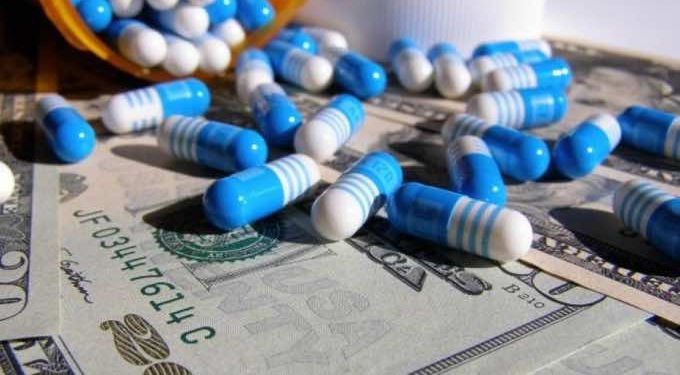
By Dana Brown | Common Dreams
Public production of essential medicines is an idea whose time has come. Broad-based support for taking this step has been growing, and on Tuesday, Sen. Elizabeth Warren and Rep. Jan Schakowsky introduced a bill that would create the public Office of Drug Manufacturing (ODM) to do just that.
The bill proposes the creation of the ODM within the Department of Health and Human Services with a mandate to produce generic drugs in cases of drug shortages, limited competition and where prices have spiked. It stipulates that the ODM would produce or procure at least 15 applicable drugs (including insulin) in its first year and offer them at a “fair price.” As Dr. Adam Gaffney, President of Physicians for a National Health Program said of the bill, “By creating a public drug manufacturer, Warren and Schakowsky’s bill could help address both problems [access and shortages], producing inexpensive drugs that will bring down costs, expand access, and shore up the drug supply chain—ensuring that every American can get the medicines they need.”
The bill is representative of growing sentiment both throughout the country and on Capitol Hill that business as usual in the pharmaceutical sector benefits neither public health nor democracy.
Nevertheless, given the complexity of the pharmaceutical market and regulatory landscape that surrounds it, no single intervention is a panacea. Warren and Schakowsky’s bill, by putting public manufacturing for the public good on the table as a real option, represents an important advance towards a system that priorities human need over corporate profit, but there are further important opportunities to expand the scope and impact of public pharma that we should not neglect.
- First, this bill focuses on the generics market—which does account for at least 80 percent of pharmaceutical sales by volume—however, it leaves aside the name-brand drug market, which accounts for 77 percent of drug spending in the US.
- Second, the bill’s commitment to “fair pricing” should be interpreted expansively to include the possibility for at- or below-cost distribution of drugs in cases of certain public health priorities.
- Third, beyond the scope of this bill is the role of middlemen in pharmaceutical pricing—a key consideration when studies show that around 40 percent of the money spent at retail pharmacies goes to intermediaries in the distribution chain.
Generics vs brand-name drugs
Many of our pressing drug cost issues have to do with medications that are still on patent. Public production of generics, as important an advance as that would be, would not be sufficient to truly address the financial strain that rising pharmaceutical prices have put on patients and the entire health system—not to mention the outsized political power wielded by Big Pharma. Legislation by Sen. Bernie Sanders and Rep. Ro Khanna is aimed at the brand-name market (through price caps based on reference pricing). Still, public pharmaceutical companies could and should take a much more proactive and direct role in addressing problems with the brand-name drug market wherever possible.
A federal public entity like the ODM may be able to use existing federal power to intervene in the name-brand market by invoking what’s referred to as government patent use (or Section 1498 of US Code 28). Section 1498 clearly states that the federal government (and its agents) can infringe on patents without license, at any time, as long as “reasonable and entire compensation” is granted to patent holders. That means the government could produce or procure generic versions of on-patent medications without permission of patent holders, as it did regularly in the 1960s and early 1970s. (In one case, the Department of Defense reportedly utilized Section 1498 to procure around 50 different patented pharmaceuticals during a three-year period in the 1960s.)
Should it be deemed that the ODM has the authority to invoke government patent use, it should use that authority actively. Some lawmakers already support Section 1498 use as a tool for lowering drug prices. This past February, eighteen members of Congress senta letter to HHS Secretary Alex Azar urging him to exercise Section 1498 rights to allow state-funded programs like Medicare and Medicaid to procure generic versions of the latest generation of Hepatitis C drugs in order to treat beneficiaries at a more reasonable cost than the $84,000 one company charges for a course of treatment. If the ODM was able to leverage that right, it could ostensibly procure and provide generics that treat or cure many diseases which currently take a huge toll on patients and society as a whole (often disproportionately affecting disenfranchised communities).
Take diabetes, for example. In 2017, the American Diabetes Association estimated that the US spent $14.98 billion on insulin alone and that some patient groups (non-Hispanic African Americans and patients under 45 years of age, for example) were forced to spend far more for their insulin than other groups. But insulin is a particularly thorny market, tightly controlled by three companies that claim 96 percent of the global market. They collectively hold dozens of patents on the latest and most widely used drugs and fiercely defend their intellectual property claims on the latest drugs through secondary patents and ongoing litigation.
Since only federal agencies have the tool of Section 1498 at their disposal, prioritizing its use by the ODM seems essential. Meanwhile, states and municipalities should also consider setting up public pharmaceutical companies that could concentrate on the generic and biosimilars markets. Together, these new entities could begin to build a multifaceted public pharmaceutical ecosystem that could be truly transformational.
Fair pricing and public health needs
In Brazil, public pharmaceutical manufacturers played a key role in the fight against HIV/AIDS by supplying low-cost antiretrovirals that were oftendistributed for free. Public entities like the ODM should not only consider the public health benefits of low-cost availability of essential drugs, but the lost economic productivity, increased health costs and disproportionate burdens on many communities caused by cost-related access issues. This might mean that the “fair price” for some medications should be at or below cost due to the overwhelming benefits to society.
The earlier cited 2017 American Diabetes Association study estimated that the total economic cost of diabetes to the United States that year had been $372 billion when accounting for not only direct health care costs, but productivity, labor force participation and premature death. Similar studies about many chronic diseases illustrate that the toll they take on society is great, both in terms of health and wellbeing, but also our economy. These considerations should be taken into account when we aim to determine what a “fair price” is for accessing essential medicines.
The middlemen
Beyond the scope of this bill is the role of the much-maligned middlemen in pharmaceutical pricing. That’s a key consideration as studies show that around 40 percent of the money spent at retail pharmacies goes to intermediaries in the distribution chain. We must develop comprehensive solutions that address the various centers of power in the pharmaceutical distribution chain. Without major changes to the pharmacy benefit manager system—the main middlemen between the drug manufacturers and consumers—low-cost drugs produced by the OBM or other public pharmaceutical companies may not truly be low-cost by the time they reach consumers. Much of the savings produced will simply disappear into the middlemen’s hands.
For that reason, I suggest looking at leveraging existing public resources such as the network of 250 retail pharmacies (and seven mail-in pharmacies)run by the Veterans Administration to potentially sell publicly-produced medications direct to consumers at cost. We should also seek to learn from other countries, like Sweden, where retail pharmacies are largely in public hands to understand the benefits and drawbacks of such a system, and understand how best to design a future, more democratic and accountable pharmaceutical development and distribution chain at home.
The multiple pharmaceutical pricing bills that have been introduced in recent months, including Sen. Warren and Rep. Schakowsky’s, represent a changing tide in America. However, each is only a piece of the puzzle. As we always say here: systemic problems require systemic solutions. To truly achieve equitable, affordable access to medicines in the US, the whole pharmaceutical sector needs to be overhauled. Hopefully, these recent bills are an indication that lawmakers at various levels around the country are ready to take the first steps in that direction.
This work is licensed under a Creative Commons Attribution-Share Alike 3.0 License





![Everything You Ever Wanted to Know About 9/11 Conspiracy Theory in Under 5 Minutes [VIDEO] | by James Corbett](https://consciouslifenews.com/wp-content/uploads/2018/09/911-a-conspiracy-theory-350x250.jpg)










